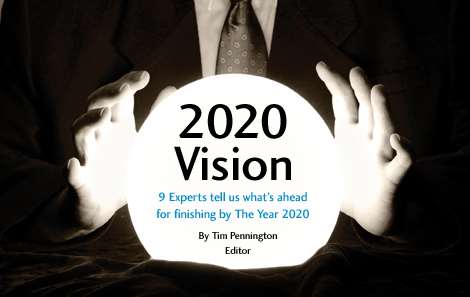2020 Vision: The Future of Coatings
The year 2020 will be here before you know it, signaling the beginning of a new decade and bringing changes to the world as we know it.
The year 2020 will be here before you know it, signaling the beginning of a new decade and bringing changes to the world as we know it:
- The 11-mile underwater Fehmarn Belt Fixed Link connecting Germany and Denmark is scheduled to be completed that year.
- Countries such as India, Malaysia, Chile, Trinidad and Tobago, Oman, Pakistan and the Philippines have all pledged to become developed countries by then.
- India says it plans a manned space mission to Mars by the beginning of the decade.
- And the Russian Federal Space Agency claims that they will be mining helium-3 from the moon by then.
But what can be expected in the world of finishing and coatings?
Featured Content
Plenty, if you listen to the experts that Products Finishing magazine asked to predict what will drive the plating, painting, powder coating, anodizing, electrocoating and vacuum coating industries by the time the next decade rolls around in 2020.
We solicited sage advice from the following experts (click their name to read their article):
- Plating: Brett Larick, President of Columbia Chemical
- Electroless Nickel: Bill Fields, CEO of Palm International and Matt Sisti, Chief Business Development Officer of Coventya, Inc.
- Ecoating: Mark Main, Product Manager of BASF Automotive Coatings and John Martin, Manager of Performance Learning for PPG
- Anodizing: Jack Humble, President of Reliant Aluminum Products
- Powder Coating: Trena Benson, Marketing Manager for DuPont Coating Solutions
- Vacuum Coatings: Alan Hardy, Market Manager for SCS Electronics
- High-Performance Coatings: Volker Mirgel, Senior VP of the Coatings, Adhesives and Specialties for Bayer MaterialScience
“We believe the industry will focus on new technologies, new innovations, and products and processes that enable the customer to be more efficient and ultimately more successful,” says Mark Main, product manager for BASF Automotive Coatings (Florham Park, NJ).
“By more efficient we mean ‘no coats’ and ‘partial coats’ with significantly less re-work for the end-user,” says Main. “Our customers demand reduced costs per part and less maintenance, with obvious end-user advantages such as easier to use and environmentally friendly products coupled with the elimination of non-value add activities.
Industry experts expect the finishing sector to grow, which should be good news for an industry hit hard when manufacturing tanked near the end of 2008 and 2009.
Economists say the global paint and coatings industry reached $99.5 billion in 2010, and is expected to have a compounded annual growth rate of 3.2% through 2015 to $116.4 billion by the mid-point of the decade.
Reportlinker.com says the powder coating and emerging technologies segment will experience the highest growth at a compound annual growth rate of 5.9% over the next decade, going from nearly $18 billion in 2010 to more than $23 billion by 2015.
“The biggest challenge in the powder coating field is the application of powder coatings on heat sensitive substrates such as wood and plastic,” says Tosko Misev, who heads the research and development department at DSM Powder Coating Resins in the Netherlands, which claims to be the largest producer of polyester resins in the world and one of the largest producers of specialty emulsions with manufacturing sites in U.S., Spain, Germany, Netherlands and China
“At present, powder coatings account for 22% of the total volume in the industrial metal market,” says Misev, who studied at North Dakota State University’s Polymer and Coatings Institute. “The situation is quite different for the industrial market for heat sensitive substrates where powder coatings represent symbolic 0.1% from the total volume.”
Misev says that for powder coating to penetrate the market for wood and plastics in the future, the curing temperatures have to be reduced below 100°C.
“Radiation curing powder coatings were expected to be the response to this challenge, but the practice showed that their acceptance was rather limited,” Misev says.
Waterborne technology coatings, with an estimated $24.8 billion in 2010 sales, are expected to grow at 5% annually to $31.6 billion in 2015, Reportlinker.com says.
A 2010 study on the U.S. electroplating, plating, polishing and anodizing industry by the website say that 2009 revenues were $6.2 billion, with an estimated gross profit of 28.44%.
The reports showed that the industry used a projected 63% of its full production capacity in 2009, meaning that full capacity was just under $10 billion annually.
But, of course, everyone is aware the finishing industry has taken a serious hit in the past decade. The U.S. government says the 2,900 businesses in the metal finishing sector face economic pressures from foreign competition and declines in the U.S. automobile industry, and has experienced an 11% decline in the number of facilities since 2000, and a 21% reduction in the number of employees.
From 1997 to 2004, the feds say, the sector experienced no growth in value added and a small annual decline in value of shipments. According to the organization Energy Industries of Ohio, electroplating operations have been particularly hard hit by rising production costs and the pressures of foreign competition that keep product prices down. In response, the EIO says the electroplating industry shows a general trend of moving overseas.
But a 2011 economic survey by IBISWorld (ibisworld.com) paints a brighter outlook for the industry looking forward.
“A recovery is on the horizon for metal plating and treating companies, as demand for industry services improves over the next five years,” IBISWorld says. “Downstream demand will begin to recover, with building and construction markets on the rise. Industry demand conditions will remain subdued in the early part of this period, reflecting the cyclical contraction in demand from the commercial building market.”
Economists from Global Industry Analysts (strategyr.com) say they expect the world electroplating market to rebound to close to $14 billion by 2015.
“Growth in the worldwide electroplating market over the last few years has constantly been on a downward trend, which can be attributed to many reasons including the growing popularity of electroless nickel-plating, the ongoing economic recession, and stringent environmental regulations that are unfriendly towards electroplating process,” the reports says. “Periods of economic downturn, which hamper growth in the manufacturing industry, typically tend to echo downstream into the metal finishing industry, including electroplating as metal finishing services and technologies are largely application driven, and depend heavily upon the net output of the manufacturing industry.”
Others say pay attention to trends in the market to enable success.
“The most significant trend in the decorative and protective coatings markets has been to more environmentally friendly coating materials,” say Brough Richey and Mary Burch, who wrote about the industry in the book Polymer Dispersions and Their Industrial Applications. “The shift away from traditional solvent borne technologies to newer technologies based on water-borne emulsion polymers, high solids coatings, and powder coatings is a key consequence of this trend.”
Richey and Burch said the change has been driven by a variety of regulatory pressures aimed at reducing air pollution by lowering the volatile organic content of the coating materials, especially in products used in the home or office.
“These economic factors have created a strong movement towards cost reduction and increases in production and distribution efficiency across the coatings industry,” they say. “In our view, the combination of continued technical innovation with improved cost efficiency presents the central challenge to the coatings industry.”
RELATED CONTENT
-
How to Apply the 720 Rule to Current Density Anodizing
What can you tell me about the 720 Rule as it applies to current density anodizing? Plating expert Sjon Westre, Ph.D., from Chemeon, answers this question.
-
Deoxidizing Aluminum as a Pretreatment
This important first step can help prepare the metal for subsequent surface finishing.
-
Test Methods For Evaluating Anodized Aluminum
Benefits of anodizing include durability, color stability, ease of maintenance, aesthetics, cost of initial finish and the fact that it is a safe and healthy process. Maximizing these benefits to produce a high–performance aluminum finish can be accomplished by incorporating test procedures in the manufacturing process.
























